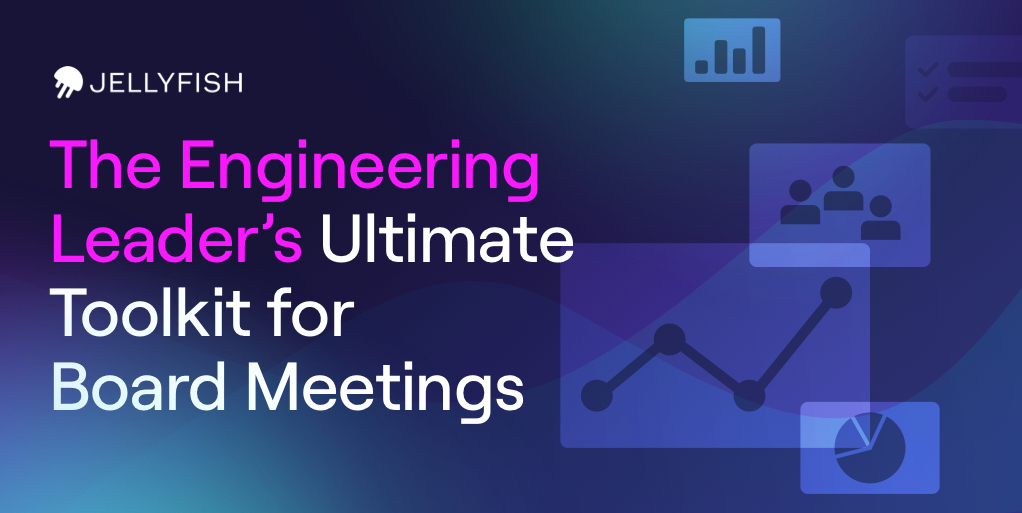Board meetings have a reputation for being stressful, high-pressure, and difficult to prepare for. The main objective for engineering leaders in this meeting is relatively straightforward: showcase engineering work in the right context so that its impact on the business can be properly understood. Simply put, leaders need to communicate the story of the engineering organization, but how you tell the story has nearly as much impact on how your message will be received by your board as the message itself. Add to the challenge that engineering concepts are often already easily misunderstood by a non-technical audience. It’s difficult to know if you are covering the right topics or going into the right amount of detail. Too often engineering leaders have to navigate this meeting without clear and consistent guidance on what to present during this meeting.
Since its founding, Jellyfish has consulted with dozens of CEOs, board members, and engineering leaders to better understand what makes a great Engineering presentation for the board room meeting. We’ve consolidated our findings into a few resources, and we’re excited to share them on our Board Meeting Toolkit for Engineering Leaders. In this post, we’ll break down the resources at your disposal that can help elevate your presentation game.
Deciding What Topics to Present
The goal of the R&D’s update for the board meeting is to tell the story of Engineering, Product, and Design. Too often this goal is lost during the presentation preparation while soliciting feedback from others. To help reinforce your story, consider organizing your presentation (data, summary points, etc) by certain topics that your board will expect to see. There isn’t a definitive set of slides that you MUST present, but there are high-level topics that can be helpful to board members while also grounding Engineering’s story. With this in mind, we spoke to board members to gauge what they’ve seen work well from R&D’s presentation, and we arrived at the 5 Topics below:
Since those initial conversations, we’ve taken these topics and turned them into a template of 5 slides that can be used and repurposed to fit any engineering leader’s needs. We also captured our conversations with executive leaders in order to present recommendations for how to speak to these slides during the meeting. You can download the full slide template here, and be sure to download the eBook, which explains the 5 slide template in more detail.
Incorporating Data and KPIs into Your Presentation
Traditionally, the slides that Engineering presents in a board meeting look quite different from other departments. One of the obvious differences is the use of data throughout the presentations. From what we’ve seen, engineering presentation content is mostly anecdotal, and the slides contain summary points of topics such as hiring, major milestones reached, etc. This is in stark contrast to the Sales department whose presentation is packed with pipeline, bookings, and market share data. The standard for Sales is that data is a staple of their presentations; we should do this with R&D presentations as well. Introducing the right KPIs to your team can help go a long way to backing up the points in your presentation, and building additional confidence in the team amongst your executive peers and board members.
If you’ve downloaded the slide template already, you’ll notice that there are quite a few placeholders for data points around these topics. But introducing data to your presentation is going to be nearly impossible if your team is not already comfortable leveraging data to inform decision-making. Before bringing data-driven insights to your board, you want to be sure that your team adopts KPIs that balance each other out, avoid the consequences of Goodhart’s Law, and prevent teams from “gaming the system.”
To help provide guidance on what can be a complicated topic, turn to the introductory list of 10 KPIs that R&D Teams Should Consider Measuring.
And once you know the metrics that you want to measure, consider technologies that can help obtain relevant data for a board meeting without being time-consuming, distracting (by pulling your team away from priorities), or sacrificing on data quality. Engineering Management Platforms (EMP) are one key technology that help with this endeavor. They process data and read signals from the tools developers already use today, and ensure data accuracy for many engineering metrics without ever interrupting developers. Not all KPIs and metrics will be measured by EMPs today, but they cover many relating to operations, collaboration, investment allocation, and deliverable progress.
Preparing for the Q&A
During preparation for a meeting, it’s natural to put the majority of your focus on the slides and your prepared remarks. But in doing so, we often overlook an important part of the presentation: the questions from the audience. Some questions are simple, others are strange, and sometimes there’s a question that will catch you off guard completely. Preparing for this portion of the presentation is similar to how you would for a job interview, where knowing the background context on why they are asking the question can be invaluable as you address the question.
For context, most of the questions directed at engineering leaders from a board member stem from a perceived gap they see at companies that they work with. Whether those gaps exist at your company or not, it’s important to know how to communicate that you’re making the right decisions based on how YOUR business operates. What works at one company, might not work at yours, and the challenge is in articulating why that’s the case. Those that are able to do so well are invaluable assets and trusted leaders within the business.
The good news is that many questions (or at least question types) can be anticipated beforehand. For example, if your team is small and in hyper-growth mode, your board is going to care deeply about hiring. They’ll ask about the pace of hiring, how you are organizing the new hires (i.e. are you organizing to scale?) and the new directors and managers that you’re bringing into the team. They’ll want to ensure that your hiring and organizational structure will grow with the company. Knowing this will allow you to not only communicate your hiring plan in the presentation, but also communicate that you understand their priorities and concerns.
To help prepare for the Q&A portion of your meeting we’ve consulted with our own CEO, Andrew Lau who was a former engineering leader himself. We talked to him about the questions that he’s seen asked from across his career, and asked for his insight into the best answers to those questions and the context behind what they’re asking. With just a bit of direction beforehand, your presentation can shine not only for the prepared portion, but also in the way you handle the unexpected.
The Board Meeting Toolkit for Engineering Leaders
All of the resources mentioned in this post can be found on our brand new Board Meeting Toolkit for Engineering Leaders page. We recommend that you bookmark this page and come back to it as your prepare for your next board meeting. We will periodically update the page to include additional resources.







